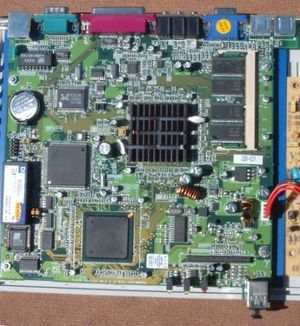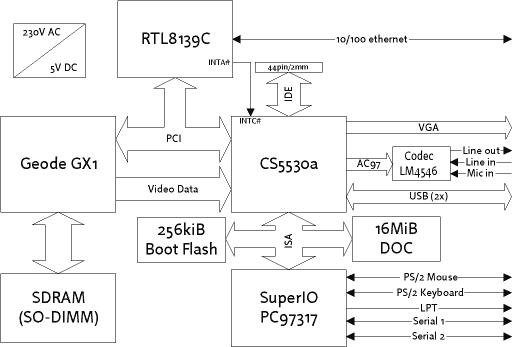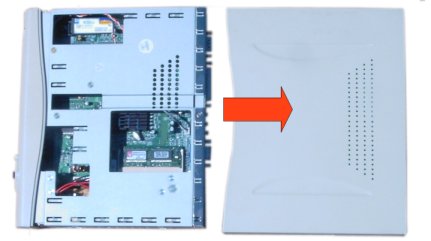Board:bcom/winnet100
The wiki is being retired!
Documentation is now handled by the same processes we use for code: Add something to the Documentation/ directory in the coreboot repo, and it will be rendered to https://doc.coreboot.org/. Contributions welcome!
The BCOM WinNET100 mainboard was sold by IGEL some years ago as their product IGEL-316. Their product was a Linux based terminal to work remotely with Windows and X.
Status
| Device/functionality | Status | Comments |
|---|---|---|
| CPU | Works | — |
| RAM | Works | — |
| IDE | Works | Tested with 2.5" disk. |
| IDE using CF-to-IDE adapter | Untested | — |
| SATA | N/A | — |
| USB | Works | Tested with irqpoll kernel parameter. Tested: USB thumb drive. |
| On-board ethernet | Works | Tested with irqpoll kernel parameter. |
| On-board audio | Untested | — |
| On-board VGA | Works | VGA support in LinuxBIOS works fine (e.g. for displaying a boot logo), for console/X11 you need a special kernel console and Xorg driver. |
| PCI add-on cards | N/A | — |
| PCI Express add-on cards | N/A | — |
| Floppy | N/A | No connector provided. |
| Serial port (COM1) | Works | — |
| Serial port (COM2) | Untested | Simple UART mode only (due to TTL level). |
| Parallel port | Untested | Running 'modprobe ppdev' works fine, but further tests were not done, yet. |
| PS/2 keyboard | Works | — |
| PS/2 mouse | Works | — |
| Smartcard reader | Untested | — |
| Mainboard sensors/fans | N/A | This CPU does not need a fan. |
| CPU frequency scaling / powersave modes | Works | Frequency Scaling on this CPU is useless. Stop clock on HLT saves more power (enabled by Linux as default). |
| Flashrom | Works | Works fine, both with LinuxBIOS and with the proprietary BIOS. |
Hardware
 | |
 |
- GX1-300B-85-20 Cyrix/National/AMD CPU with 300MHz core clock
- CS5530A-UCE part of the chipset, Cyrix/National/AMD companion device
- PC97317 Super I/O
- RTL8139C Realtec network controller
- 39F020A PLCC32 256kiB flash memory to boot
- LM4546 National, AC97 AD/DA
- DOC2000 DIL32 16MiB DiskOnChip
- SDRAM 32MiB SDRAM with 133MHz/CL2 capability as SO-DIMM
Connectors (internal and external)
- 1x PS/2 keyboard
- 1x PS/2 mouse
- 1x serial port (COM1)
- 1x parallel port
- 2x USB (OHCI)
- 1x DSUB15 VGA analogue
- 1x RJ45
- Audio: Line-in, line-out, Mic
- 1x 44pin 2mm 2.5" harddisk connector
Detailed System Information
Block diagram
The following information was gathered on a running Linux 2.6.21 system, booted via LinuxBIOS:
lspci -tv
-[0000:00]-+-00.0 Cyrix Corporation PCI Master
+-0f.0 Realtek Semiconductor Co., Ltd. RTL-8139/8139C/8139C+
+-12.0 Cyrix Corporation 5530 Legacy [Kahlua]
+-12.1 Cyrix Corporation 5530 SMI [Kahlua]
+-12.2 Cyrix Corporation 5530 IDE [Kahlua]
+-12.3 Cyrix Corporation 5530 Audio [Kahlua]
+-12.4 Cyrix Corporation 5530 Video [Kahlua]
\-13.0 Compaq Computer Corporation ZFMicro Chipset USB
/proc/cpuinfo
processor : 0 vendor_id : Geode by NSC cpu family : 5 model : 9 model name : Geode(TM) Integrated Processor by National Semi stepping : 2 cpu MHz : 300.691 cache size : 16 KB fdiv_bug : no hlt_bug : no f00f_bug : no coma_bug : no fpu : yes fpu_exception : yes cpuid level : 2 wp : yes flags : fpu tsc msr cx8 cmov mmx cxmmx bogomips : 602.14 clflush size : 32
/proc/iomem
00000000-000006d3 : reserved 000006d4-0009ffff : System RAM 000a0000-000bffff : Video RAM area 000f0000-000fffff : System ROM 00100000-01bfffff : System RAM 00100000-00253ad9 : Kernel code 00253ada-002a5f2b : Kernel data 40000000-40000fff : scratch_pad_ram 40000000-40000fff : Geode GX1 Framebuffer 40008000-400080ff : bus_interface 40008000-400080ff : Geode GX1 Bus Interface 40008100-400082ff : video_pipeline 40008100-400082ff : Geode GX1 Framebuffer 40008300-400083ff : display_control 40008300-400083ff : Geode GX1 Framebuffer 40008400-400084ff : memory_control 40008400-400084ff : Geode GX1 Memory Control 40008500-40008fff : power_control.0 40400000-407fffff : smm_area.0 40800000-487fffff : video_memory 40800000-487fffff : Geode GX1 Framebuffer febfb000-febfbfff : 0000:00:12.4 febfb000-febfbfff : Geode GX1 Framebuffer febfc000-febfcfff : 0000:00:13.0 febfc000-febfcfff : ohci_hcd febfd000-febfd0ff : 0000:00:0f.0 febfd000-febfd0ff : 8139too febfe000-febfe0ff : 0000:00:12.1 febfe000-febfe0ff : CS5530a (Kahlua) SMI handler febff000-febff07f : 0000:00:12.3 fffc0000-ffffffff : flash_memory.0
Using the hardware with a current kernel
The current 2.6.22/23 kernel does not know the CS5530 interrupt router. So it is impossible to let the kernel itself setup PCI's interrupt routing. Even if you provide the kernel with a valid interrupt routing table (PIRQ). No interrupts will work as the interrupt routing registers are still left at their reset values. The small patch below solves this issue (it was rejected in mainline as it breaks various standard BIOS based Geode systems, as they were shipped with broken PIRQ tables [1]).
How to bring LinuxBIOS in
I was not successful to boot anything other than the software in the DoC to get some information about this board. It seems a very special BIOS as it only outputs "booting os" and nothing else. Then the splash screen comes up and the graphical environment starts. One or two times I was successful to run an update of this firmware. Because the update process fails (the server it tries to connect to doesn't answer anymore), the console comes up. That's why I know they run a 2.4 kernel with an XFree86 3.x. Their software needs about one and a half minute to boot up and supports graphical resolutions up to XGA@64k colours and SXGA@256 colours.
With my own implementation (LinuxBIOSv2, Linux 2.6.2x kernel, Xorg 7.2) I boot this machine in about 10 seconds, then the xdm dialogue occures (its a terminal, not a workstation) and supports also SXGA@64k colours.
As is it hard to get a console on this system with the original software, I found no way to reprogram the boot flash in a running system. But it is very easy to disassemble the flash memory. Only 3 screws to unscrew at the reverse.
Pull the front panel to one side, the casing to the other. Ready. You now have access to all relevant parts.
To disassemble the PLCC32 boot flash ROM you need something with a hook. I'm using my SMD tweezer. Did I mention that you will need something to burn your flash?
How to build a root filesystem
This question is easy to answer. Download the following archives:
Start with the BSP, extract it and read the quickstart in Documentation/GeoTerm-Quickstart.pdf. It will guide you through the steps that are required to:
- get a generic project build system,
- get a cross toolchain for the Geode GX1,
- configure the BSP and build it,
- bring this target up and running with LinusBIOS and GNU/Linux.
The BSP builds all parts to run this Geode GX1 system. This includes LinuxBIOS and the kernel and also userland with X to run as a terminal (not as host!).
Note: This BSP includes all required patches for the kernel. You won't need the patches below.
Required patches
When you build your own kernel for this target you might need the following patches:
- This patch is needed to let Linux know the Cyrix 5530 interrupt router.
- This patch is needed as someone has overoptimised chipset tweaks so the used access macros failed. This patch is required only for kernels up to 2.6.22. From Linux 2.6.23 on it's part of mainline.
| This file is licensed under Creative Commons Attribution 2.5 License. In short: you are free to distribute and modify the file as long as you attribute its author(s) or licensor(s). |


